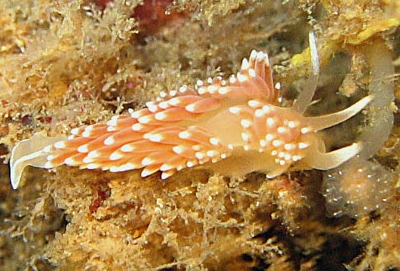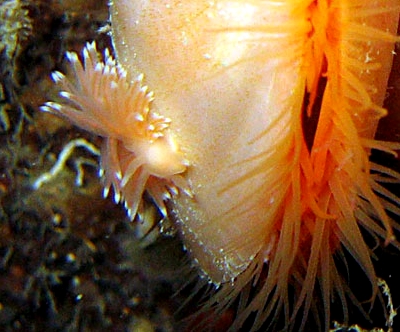Flabellina falklandica and Notaeolidia
March 14, 2007
From: Michael Schroedl

Hi Bill,
Thanks for your request for information on southern species of Flabellina. Our paper on Sth American Flabellina is taking a long time - almost ready. David Cothran's photos [message #19538] show a specimen having propodial tentacles and to my knowledge such structures have never been reported from Notaeolidia. And there are many cerata, and arranged continuously; would be good to have a pic with a dorsal view, i.e. to see whether or not cerata are arranged along the notal edge in a few rows only; doesn't seem so from the pics but may be because of the angle of view. N. gigas may have up to 4 cerata per "row", and the specimen on the pic may have 5 (4 plus a very small one). What's the size of that animal?
I think you are right in doubting that its is a Notaeolidia! It resembles Flabellina falklandica a bit, which is already known to have a wide distribution in the southern Ocean (Magellanic region, South Georgia, and even Crozet Island). Last year we found F. falklandica to be abundant in fjords and channels off the southern Patagonian iceshield (the included photos are of animals that I took during the "Huinay Fjords Expedition 2006") at depths between 10 and 20 m and temperatures steadily below 10 °C. It would be good to have an Antarctic specimen for external and internal comparision ...
However, I think Nobert Wu's "N. gigas" specimens [message #19612] are Notaeolidia rather than Flabellina. Rhinophores are long and more or less wrinkled or annulated according to the state of contraction, cerata are short in relation to body size and head tentacles, cerata appear restricted to the notal margin at least in the lower pic, specimens (at least lower one) are large, propodial tentacles are not visible, coloration differs from what I have seen in southern Flabellina etc. They are not N. depressa, that's for sure. Anyway, I' ve never seen living N. gigas or N. schmekelae other than those pics on the Forum, so difficult to give a positive statement on their id.
To be sure about potentially hidden tentacles I had a quick look at about 20 preserved Notaeolidia depressa in our ZSM collection: no propodial tentacles detactable. In contrast, preserved F. falklandica specimens show easily seen propodial tentacles. Some time ago I tentatively assigned a specimen photographed and collected by Dirk Schories at King George Island to N. gigas. From the photographs [see: http://www.guiamarina.com/antarctica/] and the preserved specimen which is in our collection: it has many cerata along the undulating notal margin, possibly up to 5 rows; and its has a wide cerata-free space on the central notum. No propodial tentacles were detectable.
All the best for now,
Michael
schroedl@zi.biologie.uni-muenchen.de
Schroedl, M., 2007 (Mar 14) Flabellina falklandica and Notaeolidia. [Message in] Sea Slug Forum. Australian Museum, Sydney. Available from http://www.seaslugforum.net/find/19656
Dear Michael,
Thanks very much for the photos of F. falklandica and your considered thoughts concerning David's animal. I must say, I still have doubts about Norbert Wu's N. gigas.
In colour and ceratal arrangement, David Cothran's animals seem to fit your photos of F. falklandica very well. We can't see whether there is a break between the anterior rows of cerata and the post-cardiac rows, and we know nothing of its anatomy - but with those provisos, I think I will identify it as F. falklandica
In a separate message [#19540 ] are photos from David Cothran of animals which match Norbert Wu's N. gigas [see message #19612 ].
Best wishes,
Bill Rudman
Related messages
-
Flabellina falklandica? from South Georgia
From: David Cothran, March 14, 2007
